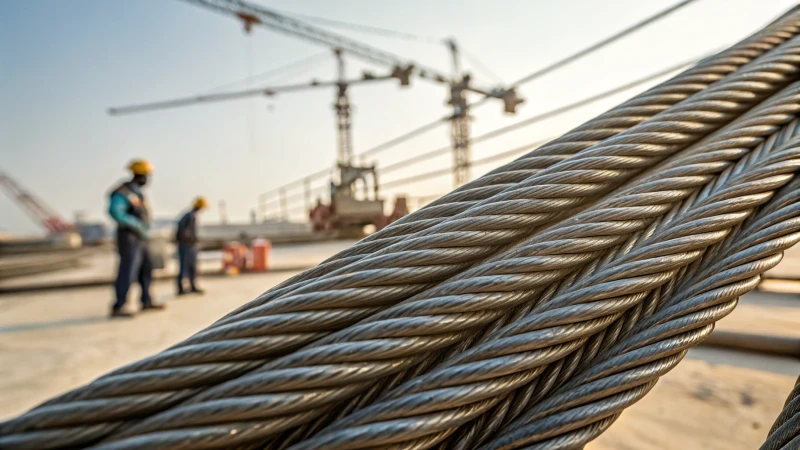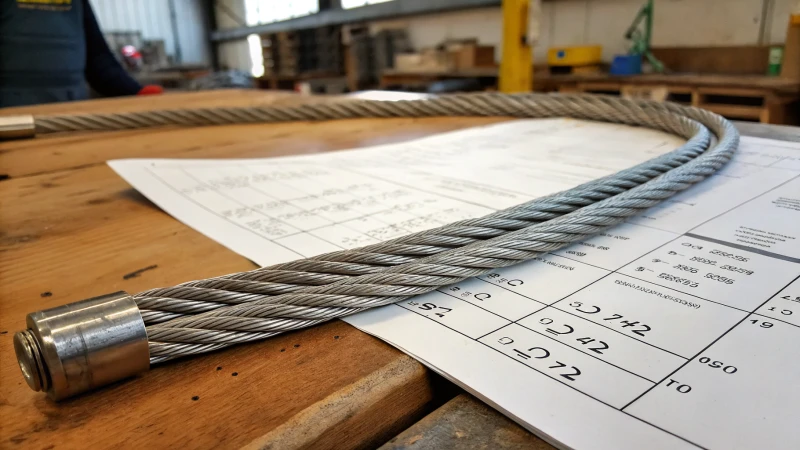
Have you ever wondered what keeps those massive cranes safely lifting tons of weight?
The load factor of crane steel wire ropes is essentially the maximum load the rope can handle, while the safety factor is a ratio that shows how much stronger the rope is than the required load. These factors are critical for ensuring cranes operate safely without risking structural failure.
I remember standing on a bustling construction site, watching cranes lift giant steel beams like they were toothpicks. It was then I realized the unsung heroes in this dance of engineering—those strong, flexible steel wire ropes. Understanding their load and safety factors is crucial. The load factor determines how much weight the rope can bear safely. Meanwhile, the safety factor acts like a safety net, indicating how much stronger the rope is compared to what it needs to carry. This knowledge isn't just for engineers; it's vital for anyone involved in crane operations to ensure everything goes smoothly and safely. Let's dive into how these factors are calculated and their pivotal role across industries.
Crane wire ropes have a safety factor of at least 5.True
The safety factor is typically set at 5 or higher to ensure safety.
Load factors are irrelevant to crane operation safety.False
Load factors are crucial for determining the maximum safe load capacity.
How Do Load Factors Affect Crane Operations?
Ever watched a crane lift massive loads and wondered about the magic behind its stability? It's all about understanding load factors.
Load factors in crane operations are the ratio of the load carried to the crane's maximum capacity. They dictate safe lifting limits and influence stability, efficiency, and safety.

The Science Behind Load Factors
I remember the first time I was part of a team managing a crane operation. The sheer size of the crane was intimidating, and I was filled with a mix of awe and anxiety. The key to mastering this giant was understanding load factors. These are essential for calculating how much weight a crane can safely lift without risking collapse or tipping. We always included a safety factor1 to handle any unexpected shifts.
Impact on Crane Stability
One windy day, I learned firsthand about the dangers of exceeding load factors. As the wind picked up, our crane started to wobble, reminding me of how crucial it is to respect these limits. Exceeding them can lead to instability, potentially causing accidents or equipment failure. By understanding load factors, I could help prevent such scenarios by avoiding conditions that would compromise stability.
| Load Factor | Impact on Stability |
|---|---|
| Within Limits | Safe and Stable |
| Exceeds Limits | Risk of Tipping |
Load Factors and Efficiency
Efficiency in crane operations is like finding that perfect rhythm in your favorite song—everything just flows. Maintaining optimal load factors is critical. I once worked on a project where pushing the limits not only strained the equipment but also increased fuel consumption and wear and tear.
Safety Protocols and Load Management
Following load factor guidelines isn't just about rules—it's about safety. I learned this during a training session where we practiced calculating load distribution2 accurately. It's about knowing the type of load, its weight, and how it's spread across the crane's arm or platform.
- Key Elements of Load Management:
- Load Distribution: Balancing weight across the crane prevents unnecessary strain.
- Load Testing: Regular tests help verify the crane's limits.
- Operator Training: Understanding load charts and considering environmental variables is essential.
Environmental Considerations
Weather can be unpredictable, as I realized when a storm hit unexpectedly. External conditions like wind speed and ground conditions play a significant role in affecting load factors. Assessing these variables is vital to adjust load capacities accordingly, ensuring safety even in adverse conditions.
For more detailed insights on how to adapt operations based on these variables, it's helpful to consult load factor tables3 that consider various environmental conditions.
Load factors determine crane lifting limits.True
Load factors help calculate the safe weight a crane can lift.
Exceeding load factors improves crane efficiency.False
Overloading reduces efficiency by straining machinery and increasing wear.
How do safety factors prevent accidents?
Ever wondered why structures rarely fail despite facing unforeseen challenges?
Safety factors are essential in accident prevention, providing a buffer against unexpected stress or material failures. By ensuring systems operate safely under varying conditions, they significantly reduce risk.

Understanding Safety Factors
Imagine walking into a building, knowing that it can withstand much more than what it's designed for. That's the beauty of safety factors—they're like an invisible safety net that engineers rely on. They're the extra bit of assurance that allows me to sleep peacefully at night, knowing I've planned for the unpredictable.
Safety factors are multipliers used to enhance the reliability and durability of components in various industries. They account for uncertainties in material properties, environmental conditions, and human errors. For instance, a safety factor4 of 5:1 means the component can endure five times the expected maximum load.
Applications Across Industries
In construction, these safety factors are the unsung heroes behind every skyscraper and bridge that stands tall against the elements. I remember when we were working on a project, and the weather forecast predicted an unexpected storm. Thanks to our use of safety factors, I felt confident that our structures could handle the additional stress.
In mining, it's similar; the robust steel wire ropes we use are designed to handle loads far greater than what we typically lift. Check out this quick glance at typical safety factors across industries:
| Industry | Typical Safety Factor |
|---|---|
| Construction | 2:1 to 5:1 |
| Mining | 3:1 to 6:1 |
| Marine | 3:1 to 7:1 |
Safety Factors in Design
When I’m selecting components like steel wire ropes5 for cranes, safety factors guide my decisions. It's not just about meeting current requirements but anticipating future needs and potential stresses. This foresight ensures that what I build today will last for years to come, regardless of what nature throws its way.
Engineers incorporate safety factors during the design phase to address potential variations in material strength and operational conditions. This practice ensures longevity and safety.
The Psychological Aspect
There's also a comfort in knowing I've done everything possible to safeguard against failure. It's like a personal insurance policy that extends to everyone using the equipment.
Safety factors also play a psychological role by instilling confidence among users and operators. Knowing that a structure or component is designed with ample safety margins reduces anxiety and encourages adherence to safety protocols6.
Ultimately, safety factors aren't just technical figures; they're my commitment to safety and reliability, ensuring every project not only meets but exceeds expectations in performance and security.
Safety factors in construction range from 2:1 to 5:1.True
Construction safety factors account for load variations and uncertainties.
Safety factors are only technical considerations, not psychological.False
They also provide psychological reassurance, boosting user confidence.
How do I calculate load and safety factors for wire ropes?
Have you ever found yourself wondering just how to ensure those hefty wire ropes don't let you down in critical moments?
Calculating the load and safety factors for wire ropes involves figuring out the Working Load Limit (WLL) and applying a safety factor, typically 5:1. This means the rope's breaking strength should be five times the maximum expected load, safeguarding against unexpected failures.

Understanding Load Factors
Let's talk about load factors. Imagine being on a construction site with machines buzzing around and loads being lifted sky-high. You wouldn't want to leave anything to chance, right? The load factor is what keeps your wire ropes in check, accounting for both static and dynamic forces. It's like having an extra pair of eyes on the weight being hoisted, plus any sneaky forces from movement or acceleration.
To determine the Working Load Limit7 (WLL), use the formula:
WLL = Breaking Strength / Safety FactorSo, let's say you've got a wire rope boasting a breaking strength of 10,000 pounds. With a safety factor of 5:1, your Working Load Limit (WLL) drops to 2,000 pounds—meaning it's all set to handle up to 2,000 pounds safely.
Safety Factors Explained
Safety factors are the unsung heroes in engineering, silently safeguarding us against potential mishaps. Picture them as a buffer zone against uncertainties. For instance, in crane operations, it's typical to have a 5:18 safety factor. Essentially, this means your wire rope should be five times stronger than any load it might lift. It's like wearing both belt and suspenders—extra safe! Sometimes, especially with heavy-duty applications, you might find even higher safety factors being used.
Calculating Safety Margins
Calculating safety margins is where things get interesting. Start by identifying the max load your rope will face. Multiply this by the required safety factor to find out the breaking strength you'll need. Here's a quick guide:
| Application | Max Load | Safety Factor | Required Breaking Strength |
|---|---|---|---|
| Construction Crane | 2,000 lbs | 5:1 | 10,000 lbs |
| Mining Hoist | 3,000 lbs | 6:1 | 18,000 lbs |
Practical Applications and Considerations
Choosing the right wire rope is like finding the perfect tool for a job—it's all about the details. From environmental conditions to wear and tear, everything matters. And don't forget about material composition9! Steel ropes with high carbon content are tough cookies but need protection against corrosion.
Regular check-ups are crucial too—think of them as health screenings for your ropes. Keep an eye out for wear or damage and switch out any compromised ropes pronto.
Remember, resources like inspection guidelines10 can be lifesavers, offering detailed protocols to help keep your operations smooth and safe.
A 5:1 safety factor is standard for wire ropes in cranes.True
Cranes typically require a 5:1 safety factor to ensure operational safety.
The WLL is calculated by dividing the max load by the safety factor.False
WLL is calculated by dividing the breaking strength by the safety factor.
Why Are Higher Safety Margins Becoming More Popular in Crane Industries?
Ever wonder why cranes seem to be getting safer by the day? Well, it turns out there's a fascinating shift happening in the industry that's making all the difference.
Higher safety margins in crane industries are becoming increasingly popular due to stringent safety standards, regulatory compliance needs, and advances in technology. These elements collectively help in minimizing risks, reducing accidents, and ensuring smooth crane operations.

The Shift Towards Enhanced Safety Standards
When I first started working with cranes, safety was a topic we couldn't afford to ignore. I remember one particular project where a slight miscalculation could have led to disaster. It's no wonder then that the industry is now more focused than ever on enhancing safety standards11. Higher safety margins mean cranes are equipped to handle more than their rated capacity, acting as a safeguard against unexpected stress.
Regulatory Compliance
In my experience, keeping up with regulations has always been a challenging yet necessary task. Governments and industry bodies are really upping the ante, requiring us to use equipment with higher safety margins to meet legal obligations. It feels like walking a tightrope sometimes—one misstep and you're facing hefty fines.
| Regulation | Region | Impact on Safety Margins |
|---|---|---|
| OSHA | USA | Requires updated safety protocols |
| EU Directives | Europe | Enforces stricter load capacities |
Technological Advancements
Technology has always fascinated me. It's incredible how advancements in materials and engineering have made it feasible to manufacture cranes that safely operate at higher loads. I remember attending a tech expo where new steel alloys and predictive maintenance systems were showcased. These innovations make it possible for cranes to work more efficiently and safely, reducing mechanical failures and extending their lifespan.
Technological innovations12 allow cranes to perform more efficiently while ensuring safety, reducing the chance of mechanical failure and extending equipment lifespan.
Risk Management and Operational Efficiency
Higher safety margins play a significant role in risk management. I can't count how many times I've seen projects benefit from having that extra capacity for error. It's a game-changer when it comes to minimizing risks associated with equipment overload. Plus, it means fewer interruptions, which keeps everything running smoothly and saves costs in the long run.
- Risk Reduction: By incorporating higher safety margins, crane operators can mitigate risks from unforeseen loading conditions or environmental factors.
- Efficiency Gains: With improved risk management13, operations proceed with fewer interruptions, leading to increased productivity and lower costs over time.
Understanding the emphasis on higher safety margins in crane industries has given me valuable insights into how our standards and practices are evolving. This push for greater safety measures is reshaping crane operations, benefiting businesses and workers alike.
Higher safety margins reduce crane operation costs.True
Enhanced safety margins minimize downtime and repair costs, boosting efficiency.
Stricter regulations decrease the need for safety margins.False
Tighter regulations actually increase the demand for higher safety margins.
Conclusion
Understanding load and safety factors in crane steel wire ropes is crucial for safe operations, ensuring they can handle maximum loads while providing necessary safety margins against unexpected stresses.
-
Discover how safety factors ensure cranes operate within safe limits, preventing overload-related accidents. ↩
-
Learn about the importance of even weight distribution in maintaining crane stability during operations. ↩
-
Explore tables that help operators adjust crane capacities based on environmental conditions. ↩
-
Explore how safety factors provide a buffer against design uncertainties and enhance structural reliability. ↩
-
Understand the critical role of steel wire ropes with adequate safety factors in crane operations. ↩
-
Learn about the various safety protocols that complement safety factors in engineering applications. ↩
-
Exploring this link provides formulas and guidelines for calculating safe lifting limits based on wire rope specifications. ↩
-
This link offers insight into industry-standard safety factors essential for safe lifting operations with wire ropes. ↩
-
Discover how different materials affect wire rope strength and durability by checking out this detailed resource. ↩
-
This link outlines critical inspection procedures to ensure the ongoing safety and effectiveness of wire ropes. ↩
-
Learn about the latest safety standards for cranes to ensure compliance and protect workers from potential hazards. ↩
-
Discover how new technologies are improving the performance and safety of cranes, enhancing their efficiency and reliability. ↩
-
Explore effective risk management strategies that can help improve safety and operational efficiency in crane operations. ↩

